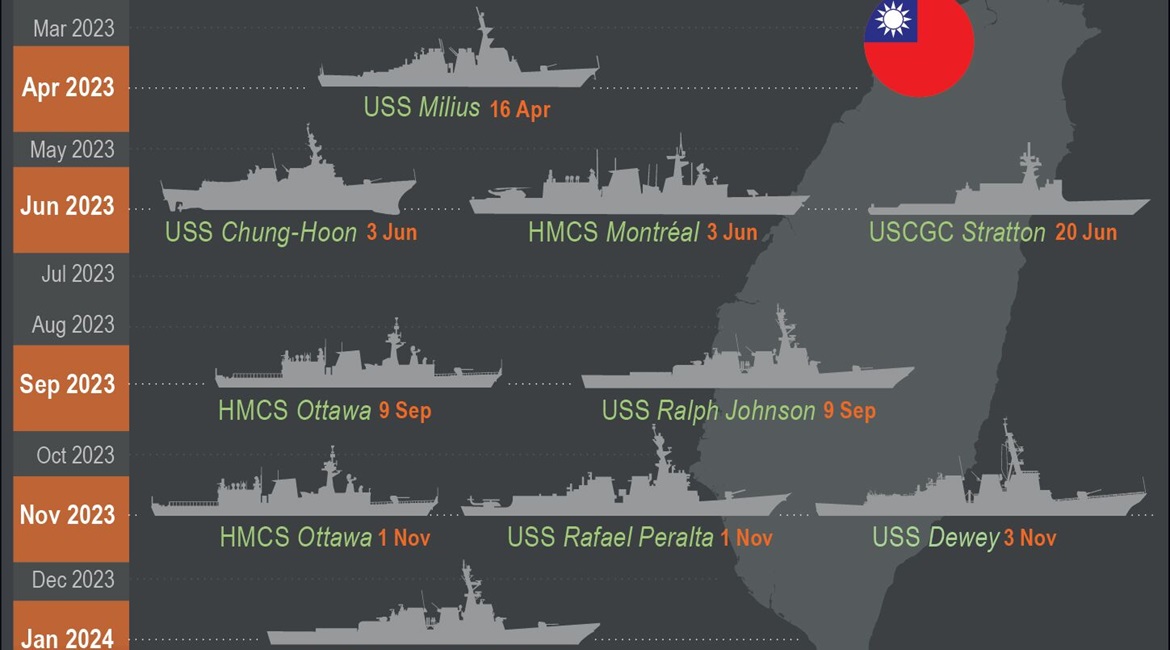
Date Posted: 03-Jun-2024
Authors: Sarbhanu Nath and Saurav Sarkar
Janes analysts have established 17 indicators across the PMESII spectrum to track, analyse, and assess developments that may lead to changes in the intent and capabilities of China and Taiwan to unilaterally change the situation across the Taiwan Strait.
Key Points
- Between August 2023 and January 2024 China's political statements on reunification, use of trade as leverage against Taiwan, and military actions, and Taiwan's efforts to reduce trade and investment with China and growing defence ties with the United States have been the main drivers of tensions across the strait
- Several factors have very likely contributed to mitigating tensions, such as an increase in cross-strait people-to-people engagement; continued trade; and existing, albeit limited, party-level engagement between the Communist Party of China and Taiwanese political actors
- In the next six to 12 months, Janes assesses that tensions between China and Taiwan are almost certain to persist, but military confrontation is unlikely
Military
Force distribution and posture
Force distribution and posture is unlikely to exacerbate tensions between China and Taiwan in the next six months. The following factors inform this assessment:
- Taiwanese deployment of military equipment is largely defensive in nature while there has been relatively fewer deployments of Chinese long-range fires and amphibious capabilities
- No additional PLA assets deployed near the Taiwan Strait
- It is almost certain that the PLA will commission the Type 003 (Fujian) aircraft carrier in the next six to 12 months, which will very likely increase tensions.
Chinese PLA
Notable equipment updates observed from August 2023 to January 2024 in the PLA's Eastern Theater Command (ETC) and the Taiwanese armed forces include:
J-20 fifth-generation fighter aircraft
In October 2023 Janes observed the PLA Air Force's (PLAAF's) 8th Fighter Brigade operating the fifth-generation J-20A fighter aircraft from Changxing Air Base in northwestern Zhejiang province based on satellite imagery from 10 September 2023. The J-20A is also operated by the ETC's 9th Fighter Brigade located at Wuhu, southeastern Anhui province, making the ETC the first theatre command to have more than one confirmed operational J-20A unit.
Fire Dragon 480 tactical ballistic missile
In November 2023 Janes reported that the PLA Ground Force's (PLAGF's) 71st Group Army inducted a new 750 mm tactical ballistic missile known as the Fire Dragon 480 that can be fired from the PHL-16 multiple rocket launcher (MRL) system. The missile has a circular error probable (CEP) accuracy of 30 m at maximum range and has a 480 kg high-explosive fragmentation warhead (HE-frag). A Norinco (the missile's manufacturer) official told Janes in 2018 that the maximum range of the missile was 290 km but according to Chinese media outlets the missile's range has likely been increased to 500 km.
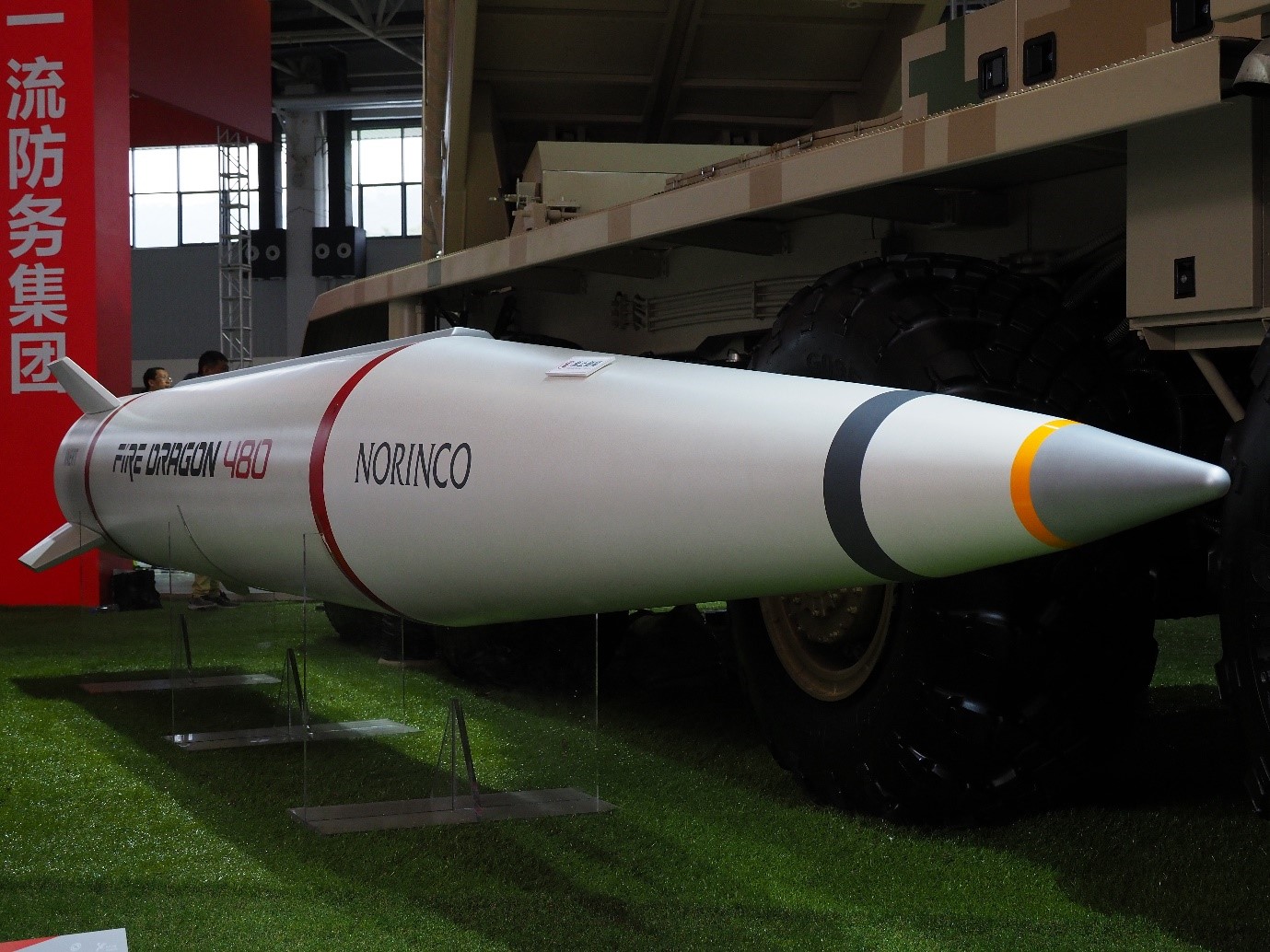 Fire Dragon 480 tactical ballistic missile. (Janes/Kelvin Wong)
Fire Dragon 480 tactical ballistic missile. (Janes/Kelvin Wong)
The PLA Rocket Force (PLARF) is replacing short-range ballistic missiles (SRBMs) with a range of around 600 km in the 61st Base with medium-range ballistic missiles and as such the PLAGF is likely to be tasked with operating SRBMs. Compared with the DF-11 SRBM's transporter erector vehicle that can load just one missile, the PHL-16 can load two Fire Dragon 480s. It is likely that the deployment of the PHL-16 and the Fire Dragon 480 missiles in the 71st Group Army was partly driven by Taiwan's ongoing procurement of 29 M142 High-Mobility Artillery Rocket Systems (HIMARSs) from the US by 2026.
New infantry fighting vehicle
Janes reported on 7 November 2023 that according to a video released by state broadcaster China Central Television (CCTV), the 145th Medium Combined Arms Brigade of the 73rd Group Army inducted an unknown number of new infantry fighting vehicles (IFVs), likely the Type 19 (also designated as Type 22), at a ceremony in eastern Guangdong. Images of the new IFV show two propellers located on the hull's aft and a trim vane mounted on the glacis. This indicates that the new IFV, like the ZBL-09, is amphibious. Janes assesses that the IFV's turret appears to be an unmanned type based on the lack of hatches in the turret roof.
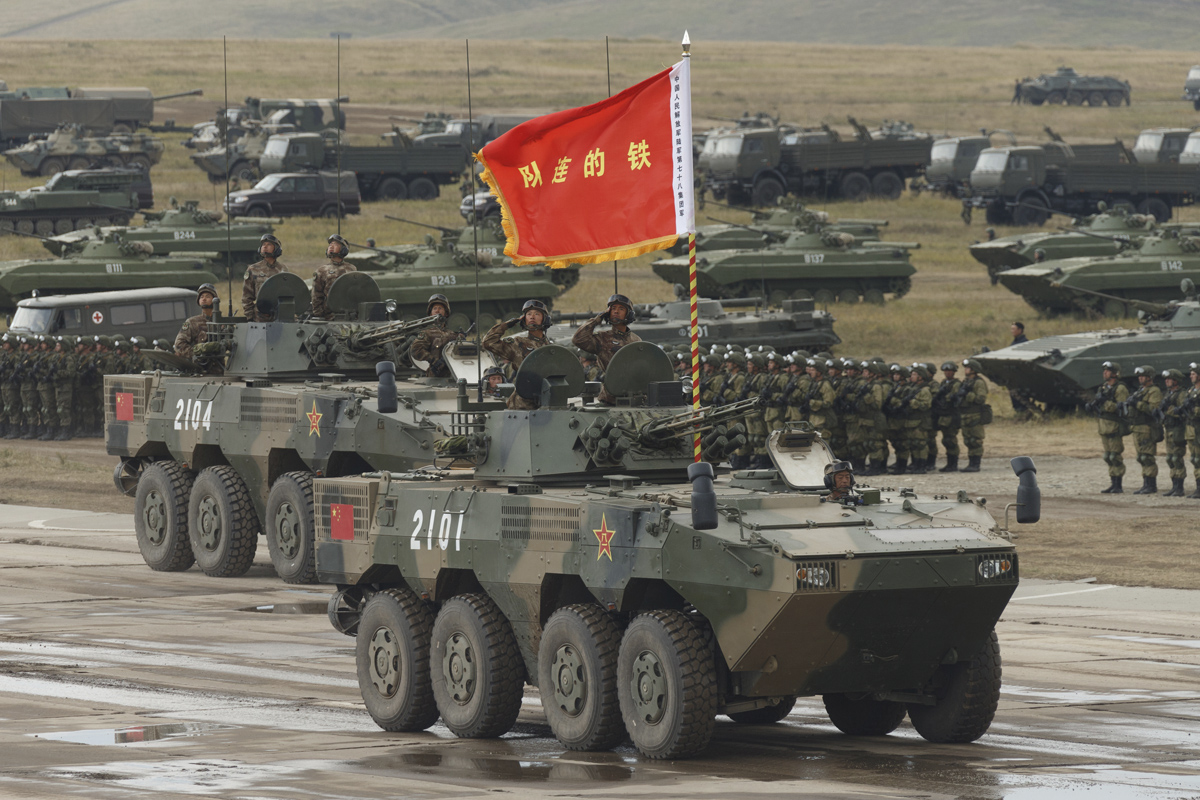 The Type 19 IFV features a hull identical to that of the ZBL-09 IFV (pictured above) in service with the PLA and a new turret. (Russian MoD)
The Type 19 IFV features a hull identical to that of the ZBL-09 IFV (pictured above) in service with the PLA and a new turret. (Russian MoD)
Republic of China Armed Forces
Air-defence systems
In mid-September 2023 a Republic of China Air Force (RoCAF) officer told Janes that the service is deploying several air-defence systems along Taiwan's coasts to intercept Chinese missiles. A National Chung-Shan Institute of Science and Technology (NCSIST) source said a limited number of Sky Sword II (Tien Chien II) medium-range surface-to-air missile (SAM) units have been deployed by the RoC Army's (RoCA's) artillery force as well as on the RoC Navy's (RoCN's) Tuo Chiang-class corvette and Yushan-class landing platform dock (LPD) warships.
 The Tien-Kung III, a mid-/long-range surface-to-air missile system, displayed at TADTE 2023. (Janes/Kapil Kajal)
The Tien-Kung III, a mid-/long-range surface-to-air missile system, displayed at TADTE 2023. (Janes/Kapil Kajal)
The major changes in military deployments and equipment upgrades observed from August 2023 to January 2024 in the PLA's ETC and the Taiwanese armed forces are unlikely to lead to any changes in cross-strait tensions. The equipment updates noted in Taiwan include air-defence and anti-ship platforms to defend against increasing Chinese long-range fires capabilities such as ballistic missiles and artillery while also being able to target Chinese naval ships. Chinese military deployments and upgrades while notable have not been conducted in an expansive or uniform manner across the ETC, with most changes focusing on boosting or introducing niche capabilities such as the PLAGF's long-range fires and the PLAAF's air superiority platforms. The number and types of equipment inducted into the PLA ETC during this reporting period is similar to the previous reporting period, which saw ZBL-09 IFVs, short- and long-range artillery and short-range air-defence systems also being deployed.
Military actions
Military actions are likely to increase or decrease tensions between China and Taiwan in the next six months. The following factors inform this assessment:
- PLA activities or exercises did not restrict access to Taiwanese waters and airspace and were less provocative compared with previous six months
- The PLA is likely to continue developing its joint warfare capabilities, including amphibious and anti-access/area denial (A2/AD) exercises, as well as improve operational synergy with relatively new assets such as its aircraft carries
- China will likely seek to demonstrate its military strength to Taiwan's newly elected government as well as to deter Taipei's international partners
Taiwanese military exercises
From August 2023 to January 2024 Taiwan held several military exercises largely focusing on coastal defence. These exercises were mostly held in areas Taiwan identified as ‘red beaches' in early 2023 that the PLA could use to conduct an amphibious landing during a conflict. These included 14 beaches in Jinshan (North), Jinshan (South), Linkou, Fulong, Zhuangwei, Luodong, and Linyuan. For more information on these drills, please seeTaiwan conducts drills to counter Chinese amphibious landings .
Janes assesses that these drills are unlikely to lead to increased cross-strait tensions because they were held within or close to the Taiwanese mainland and were limited in their scope and number of assets. If similar exercises were conducted near the Kinmen or Matsu islands, which are closer to the Chinese mainland or in locations on the Chinese side of the median line, then these would likely lead to protests or intimidating military actions from Beijing.
Chinese military exercises
From August 2023 to January 2024 Janes observed multiple PLA exercises and activities near Taiwan largely focusing on joint warfare capabilities, amphibious drills, and aircraft carrier operations.
On 19 August 2023 the Ministry of National Defense (MND) of the People's Republic of China said it launched a joint air and sea combat readiness operation with forces from the PLA's ETC around Taiwan in response to Taiwanese Vice-President Lai Ching-te's visit to the US. According to the Chinese MND the exercise focused on “ship-aircraft co-ordination, seizure of control areas, submarine detection and tracking, and simulated anti-submarine warfare [ASW]”. Chinese state media, such as CCTV, broadcast footage showing H-6K bombers of the 28th Air Regiment in flight but these were not detected within Taiwan's air-defence identification zone (ADIZ). According to the Taiwanese MND 27 PLA aircraft entered Taiwan's ADIZ on 19 August, including 25 fighter aircraft (nine Su-30s, four J-11s, and 12 J-10Cs) that crossed the median line. Janes assessed that the PLA aircraft flew longer distances along the Taiwanese side of the median line than usual.
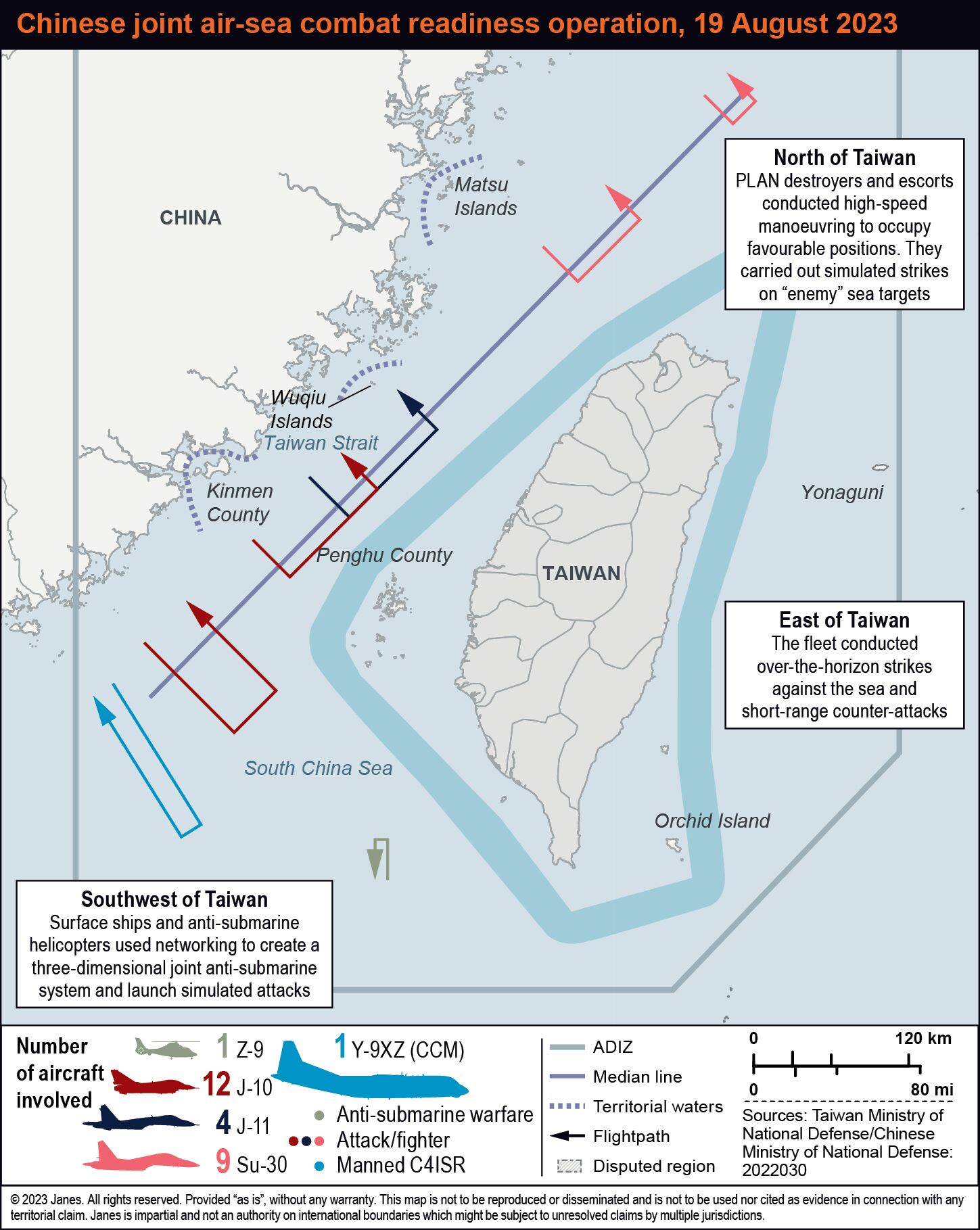 Chinese joint air-sea combat readiness operation, 19 August 2023. (Taiwan Ministry of National Defense/China Ministry of National Defense)
Chinese joint air-sea combat readiness operation, 19 August 2023. (Taiwan Ministry of National Defense/China Ministry of National Defense)
For more information on this operation, please see China claims joint air-sea combat operation around Taiwan .
On 31 October 2023 the Taiwanese MND detected several PLA aircraft and six PLA Navy (PLAN) vessels around Taiwan. The PLA's KJ-500 airborne early warning and control (AEW&C) aircraft was among those detected by the Taiwanese MND, which seemed to be conducting operations with the Shandong CSG. On 1 November 2023 the Taiwanese MND observed two KJ-500 aircraft alongside other aircraft including an electronic intelligence (ELINT) variant of the Y-8. These aircraft flew along the southern end of the Taiwan Strait and the Bashi Channel, which correspond to the southwestern and southeastern ends of Taiwan's ADIZ. It is likely that the operation of the KJ-500s alongside the Shandong Carrier Strike Group (CSG) indicates that the PLA is working to refine its carrier-based battlespace command-and-control (C2) capabilities. For more information on this exercise, please seeChina sharpens carrier-borne battlespace management capabilities near Taiwan .
On 5 November 2023 state broadcaster CCTV aired videos of Z-10 attack helicopters from the PLAGF's 73rd Group Army's Aviation Brigade firing rockets in simulated attacks on maritime targets off the coast of Fujian. CCTV reported that the Z-10s were conducting massed attacks at altitudes of 500–600 ft; this was likely to practise reducing radar signatures in low-altitude operations to conduct saturation attacks.
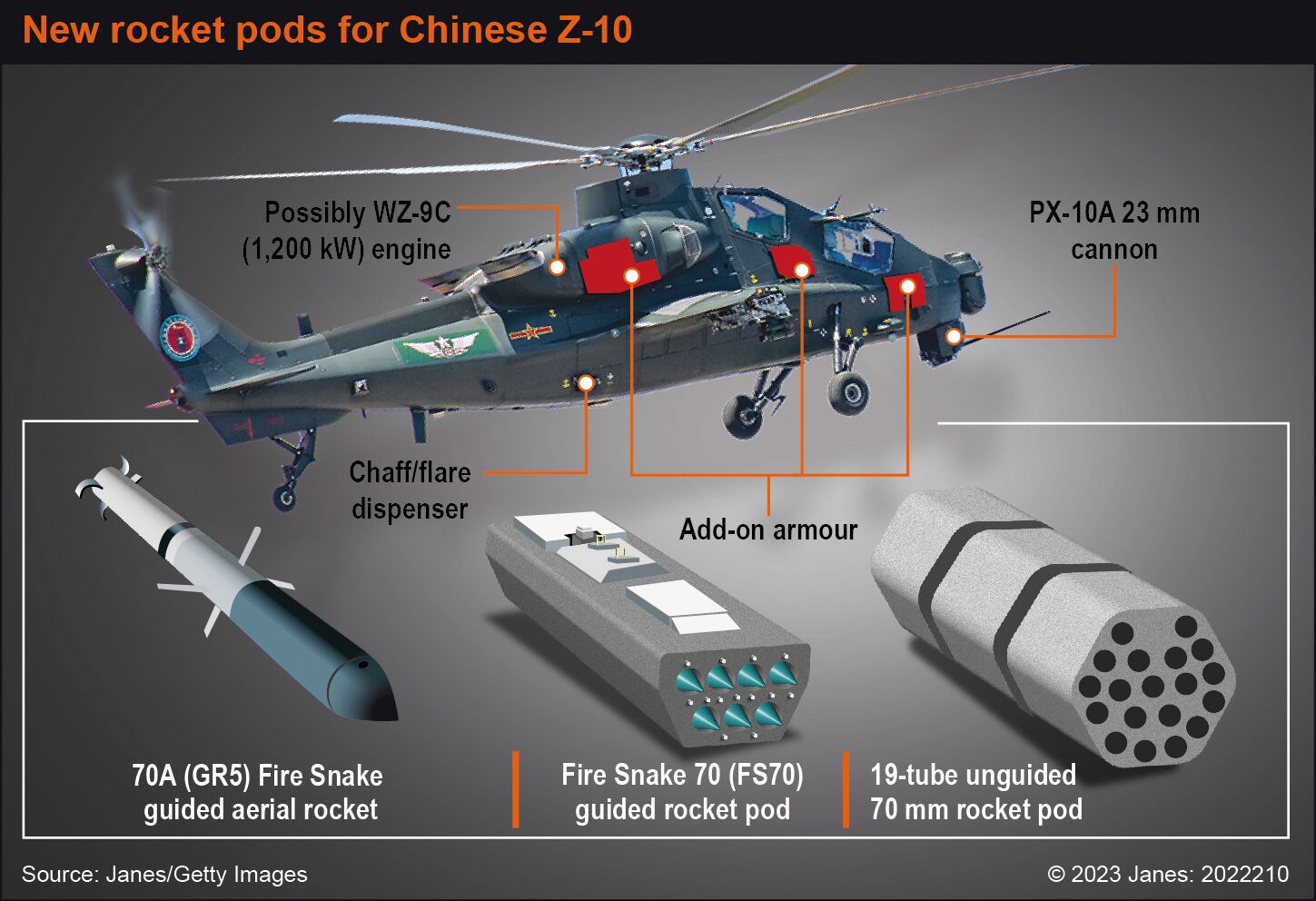 New rocket pods for Chinese Z-10. (Janes/Getty Images)
New rocket pods for Chinese Z-10. (Janes/Getty Images)
Chinese incursions into Taiwan's ADIZ
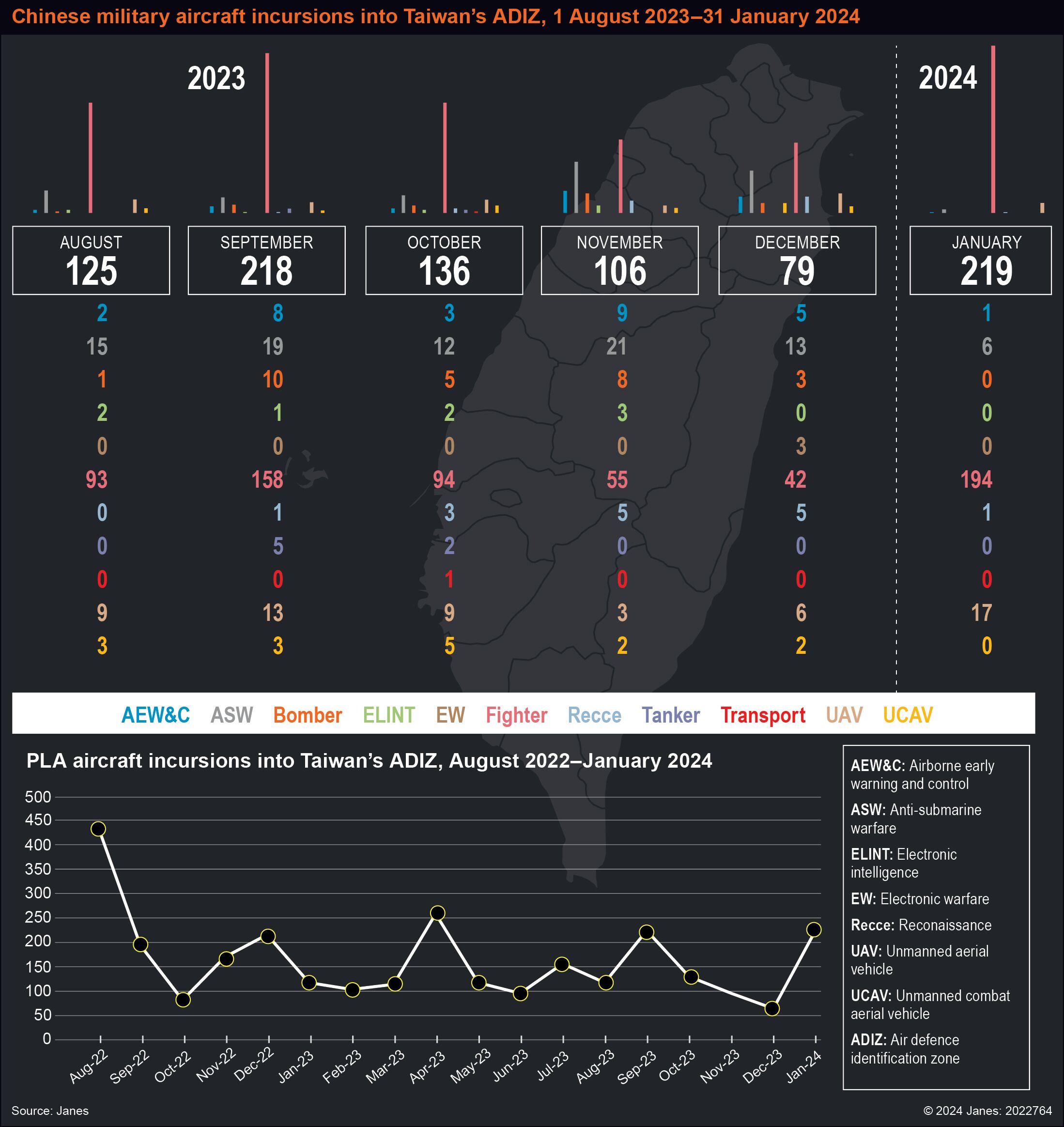 Chinese military aircraft incursions into Taiwan's ADIZ, 1 August 2023–31 January 2024. (Janes)
Chinese military aircraft incursions into Taiwan's ADIZ, 1 August 2023–31 January 2024. (Janes)
According to Janes data, from August 2023 to January 2024 China sent around 883 aircraft into Taiwan's ADIZ. These included 636 fighter aircraft (72%), 86 ASW platforms (9.7%), 72 drones (8.1%), 54 command, control, communications, computers, intelligence, surveillance, and reconnaissance (C4ISR) platforms (6.1%), 27 bombers (3%), seven tankers (0.8%), and one transport aircraft (0.1%). September 2023 and January 2024 had the highest numbers of aircraft involved, 218 and 219 respectively. This is almost certainly because of the PLA exercises in September 2023 and the Taiwanese presidential election in January 2024. Meanwhile, in October 2023 China's Wing Loong II (GJ-2) strike-capable unmanned aerial vehicle (UAV) was detected for the first time in Taiwan's ADIZ, which was likely deployed in support of a Chinese space satellite launch on 5 October. Overall, the number of PLA aircraft intruding into Taiwan's ADIZ from August 2023 to January 2024 was almost similar compared with that recorded for the preceding six months (873 aircraft).
Janes assesses that the PLA activities near Taiwan observed during the reporting period did not significantly change cross-strait tensions, given their relative distance from Taiwanese waters, except for ADIZ incursions by PLA aircraft, which is a regular occurrence. These exercises were less provocative and smaller compared with those observed in the previous reporting period with no attempted blockade of Taiwan or aggressive actions such as firing of munitions into or over Taiwanese waters/airspace. It is very likely that these exercises are intended to continue improving PLA joint warfare capabilities and its C4ISR assets such as AEW&C and ELINT aircraft operating in a maritime environment with relatively new platforms such as the Shandong. It is likely that in the next six to 12 months the PLA expands the scope and nature of its military exercises with increased focus on amphibious operations and A2/AD capabilities in the Taiwan Strait area. China will likely seek to demonstrate its military strength to Taiwan's newly elected government as well as to deter Taipei's international partners from getting involved in cross-strait confrontations.
External actors
Military external actors are very likely to exacerbate tensions between China and Taiwan in the next six months. The following factors inform this assessment:
- The US passed legislation authorising military support for Taiwan in fiscal year (FY) 2024
- The US approved sales of defence equipment to Taiwan, and in response China imposed sanctions on US defence companies participating in the sales
- The US Navy (USN) has carried out multiple freedom of navigation operations (FONOPs) through the waters of the Taiwan Strait, actions which are strongly opposed by the Chinese government.
On 22 December 2023 the US president signed into law the National Defense Authorization Act (NDAA) for Fiscal Year 2024. The 2024 NDAA mentioned Taiwan only in the context of training and expansion of co-operation on military cyber-security activities between Taiwan and the US. The NDAA mentioned that as part of the US' efforts to strengthen its posture in the Indo-Pacific region, a comprehensive training and advisory programme would be held in FY 2024 to support the Taiwanese armed forces. The NDAA also requires the US Department of Defense (DoD) to co-operate with the MND of Taiwan on defensive military cyber-security activities. In contrast, the 2023 NDAA authorised USD10 billion in security assistance for Taiwan along with fast-tracked weapons procurement for the country. China protested strongly against the passage of the 2023 NDAA and lodged an official diplomatic protest with the US after the passage of the Act. On 28 December 2023 China's MND issued a statement in which it expressed strong dissatisfaction with and firm opposition to the NDAA, stating that the NDAA “interfered in China's internal affairs” and “seriously undermined China's interests”. The less stringent Chinese reaction to the 2024 NDAA is very likely due to the lack of direct US military or financial aid to Taiwan.Between August 2023 and January 2024 the US approved sales of USD500 million in August and USD300 million in December of defence-related equipment to Taiwan. In response to the December sale approval, on 7 January China's Ministry of Foreign Affairs announced that it would sanction five US defence companies. As a result of the sanctions, the assets of these firms in China would be frozen and organisations and individuals in China would be prohibited from doing business with these firms. In the previous six-month period from February to July 2023, the volume of arms sales approved by the US to Taiwan totalled USD1.05 billion. China imposed sanctions on two US companies during that period for their involvement in arms sales to Taiwan.
Taiwan Strait transits
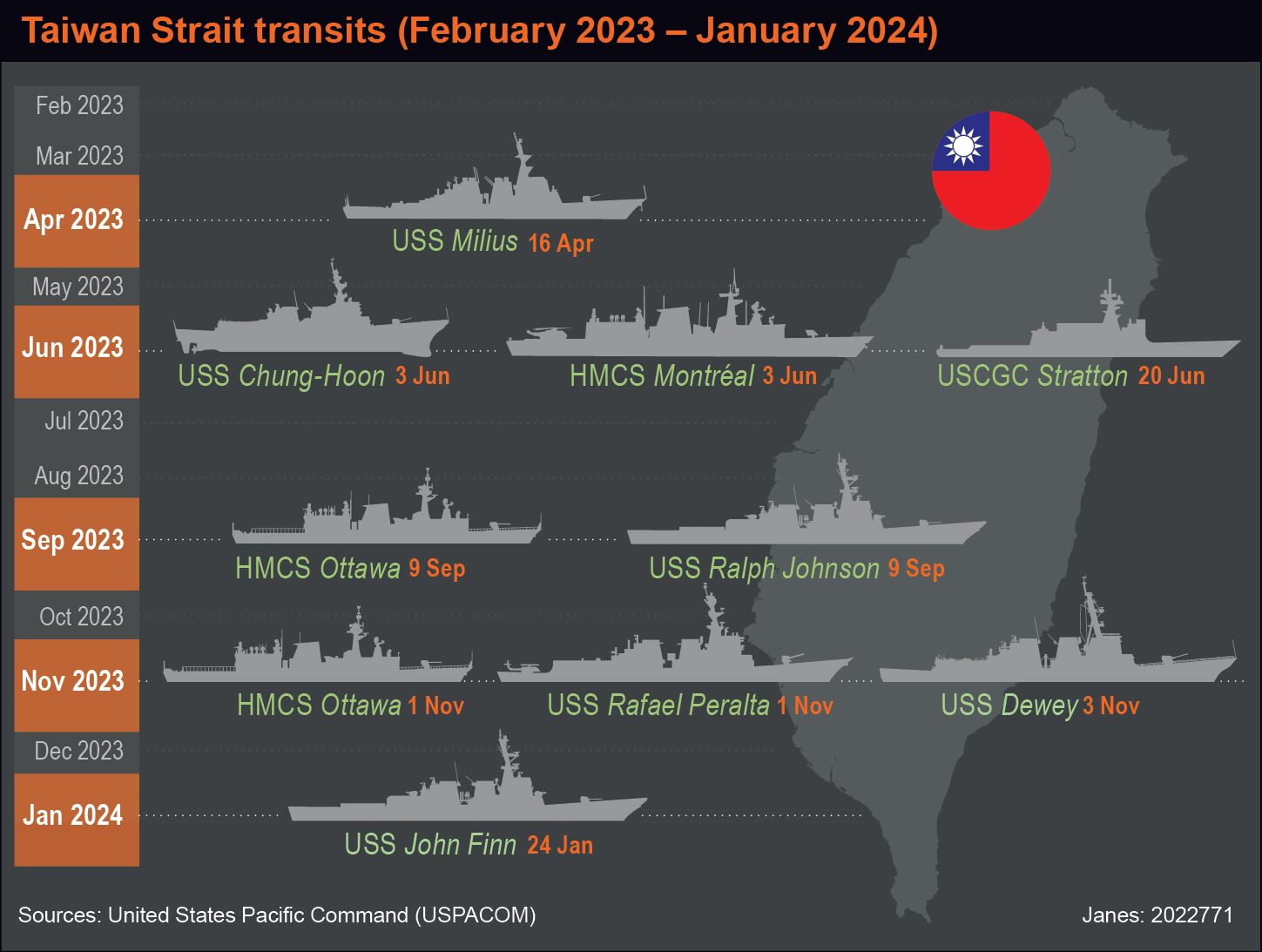 Taiwan Strait transits (February 2023–January 2024). (United States Pacific Command (USPACOM)/Janes)
Taiwan Strait transits (February 2023–January 2024). (United States Pacific Command (USPACOM)/Janes)
Between 1 August 2023 and 31 January 2024 the USN conducted four FONOPs in which they transited through the Taiwan Strait. China strongly opposes such exercises, which it says are threats against its sovereignty, and it considers the entirety of the Taiwan Strait as part of its exclusive economic zone (EEZ). The US and its allies have conducted freedom of navigation exercises through the strait for many years to emphasise their stance that the Taiwan Strait is part of international waters. This represents a decrease from the previous six-month reporting period, which saw seven instances of FONOPs through the Taiwan Strait. On 9 September 2023 and again on 1 November 2023 a US destroyer and a Canadian frigate transited through the Taiwan Strait as part of FONOPs. After the 1 November transit, China's ETC issued a statement in which it stated that Chinese troops in the area remained on high alert and that its naval and air assets had “trailed” the US and Canadian ships throughout. On 3 November 2023 and again on 24 January 2024 one US destroyer transited through the Taiwan Strait. Although the number of transits reduced compared with the previous 12-month period, each transit contributes to raising tensions in the region in the immediate term. The US vessel's transit operations and Chinese military units monitoring them, at times at close range, increase the risk of accidental confrontation.






